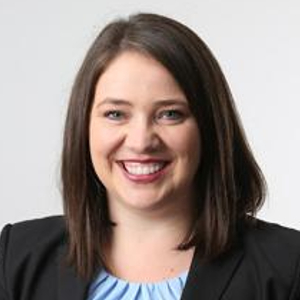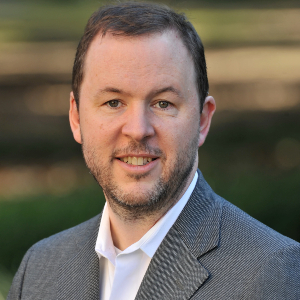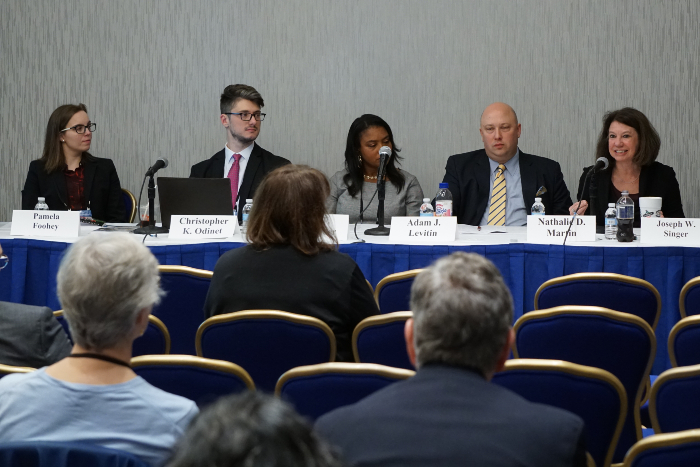By Madelyn Osgood
As part of the ongoing “Spotlight on Sections” series, AALS sat down with the leadership of the Section on Trusts and Estates for a Q&A. The Section on Trusts and Estates promotes the communication of ideas, interests, and activities among members and makes recommendations to the association on matters of interest in the teaching and improvement of the law relating to Trusts and Estates.
Chair: Natalie M. Lynner, Drake University Law School
Chair-Elect: Philip T Hackney, University of Pittsburgh School of Law

Natalie M. Lynner, Drake University Law School
 Philip T Hackney, University of Pittsburgh School of Law
Philip T Hackney, University of Pittsburgh School of Law
How did you get involved in the Section on Trusts and Estates and why did you decide to join the leadership?
Natalie Lynner: I’ve been a member of the Section on Trusts and Estates ever since I started my first academic job almost 10 years ago. I was a visiting professor at Stetson University and my mentors recommended that I join. I attended the first meeting nervous and worried about meeting members. I was impressed by how friendly and welcoming everyone was. Out of all of the section meetings I attended, Trusts and Estates stood out to me. This section is smaller in size and everyone was eager to speak to me. It is cohesive and welcoming that way.
Philip Hackney: Generally, I write in tax exempt organizations and non-profit organizations. My natural home is tax and philanthropy in the law. I started in that section and one of my colleagues suggested that I join the Section on Trusts and Estates. I have done trusts for a long time because they are at home within the tax-exempt space, particularly charitable trust, but they are also at home within tax law and their relationship within those. It’s been a great expansion of the way I think about the law in general.
What is the section’s leadership structure?
NL: We have four executive members: the chair; chair-elect, who does the programming for the upcoming Annual Meeting; treasurer; and a secretary, whose main job is to compile a newsletter of the achievements and happenings in our section for the prior year. Last year, we decided to add a full executive committee with several members. Right now, the executive core membership selects who joins and cycles through each of the four roles. And we’re considering changing that to a section-wide election.
What kind of work do your members do?
PH: Our members do work in a wide range of things, mostly involving trusts. Trusts impact many different kinds of law, including family law and charitable law. It impacts the panoply of things that people do within the law.
NL: Our section has such impressive scholars who write the textbooks we teach. I’m always impressed by how many of our members are members of other national associations in trusts and estates, such as the American College of Trust and Estate Council (ACTEC). The ACTEC is a preeminent national organization of both lawyers and academics who practice in this area. In wills and trusts, the academics push the law forward in a unique way. We have a very robust and active group of scholars and I’m proud to be a member of it.
What is the best way for interested faculty to get involved with this section?
NL: Reach out and let the leadership team know that you’re interested. Shoot us an email, come to our session at the AALS Annual Meeting, and submit papers for our call for papers.
PH: I would highly encourage interested faculty to submit papers. Our section loves scholarship and wants to hear from voices out there that may feel intimidated in some way. We’re a welcoming section that is actively engaged in thinking about trust law and how to advance it in a way that promotes justice.
What are your goals for the section this year?
PH: Our goal is to have a great Annual Meeting with interesting scholarship, to expand our membership, and maintain connection between our members. The promotion of our members’ scholarship is also an important goal. The pandemic tore connections asunder, so it is important to figure out how to be back in person. I’ve been to a couple conferences lately and they’re at once terrifying and exhilarating: terrifying to be in contact with people because we’ve been worried of getting COVID and still are, and exhilarating because I realize how much I treasure the communities that we build together in person. It’s an incredible jewel to me.
NL: Our goal is reconnecting with each other as a section and adding more input and collaboration with the new executive committee members. Conducting events remotely has taken away from the small talk that happens in person. We’re also doing a works-in-progress session at the Annual Meeting in San Diego this year. We have a goal to mentor junior faculty members who are joining this section and reach out to new members. Overall, connecting, celebrating, and sharing our scholarship, and working through this new executive committee are our goals.
How do your members interact and collaborate outside of the Annual Meeting?
NL: Faculty might go to ACTEC or a law school symposium. The leadership team has more communication with the panelists before and after, so there’s always that collaboration of reading. The discussion list is active within our section as well.
PH: The section newsletter gets relevant information out to members, such as the different types of symposia and papers that have been published.
What is the section planning for the 2023 Annual Meeting?
PH: We have two panels this year: a works-in-progress session and a pedagogy panel. We are encouraging people to submit new work in various stages of development for the works-in-progress panel. The pedagogy panel focuses on professors sharing what they have learned from the pandemic in teaching Trusts and Estates and how to relate to our students, the law, and the changing modes of law. We’re looking for broad ideas in terms of how to approach those ideas from how to use technology, to how to incorporate race and gender and other modes of justice.
NL: We’re collaborating with the Section on Art Law in a panel discussion about taking donations in return for naming rights and when that becomes a liability. We’ve seen that issue in the news recently, and it affects charitable giving. Our pedagogy panel will hopefully address how to make sure our curriculum is more diverse and inclusive. There isn’t as much critical race theory in this field, and that’s a shame because there’s a lot to talk about with inequality in inheritance, the way that our system reinforces wealth segregation, and the implications that can have on diverse and minority groups.
How did you become interested in trusts and estates?
NL: My interest began in law school. I took all the Trusts and Estates classes the law school offered. I practiced in big law after law school and did a clerkship. I didn’t see many wills and trust issues that came up. When I started teaching, I suggested that I wanted to teach property and wills and trusts. I’ve never looked back and it’s one of my favorite courses to teach throughout my almost 10 years.
PH: I was always interested in business law, so I’m interested in organizational structures. I didn’t focus on trust and estates early on. I was more focused on partnerships and corporations and the way those organized together. After doing corporate work, I went back to get my master’s in tax law at NYU. There, I decided to focus on charitable organizations.
Once you go down that path within tax law, you’re forced into understanding trusts and estates. It’s an essential element of that realm because they play such a dominant role in that experience. I worked at the IRS and I had to deal with some trusts in that experience. It’s an essential element and it influences much of charitable tax law because you have to understand the fiduciary duties that are involved with trusts, which are different than corporations. Having a strong understanding of the relationship of trusts to ourselves, as well as corporations to ourselves, and the combination within that world got me interested and engaged in those rules.
How has trusts and estates and your approach to teaching it changed over time?
NL: As I’ve become more comfortable teaching in wills and trusts, I have tried to incorporate more lawyering skills into the classroom. It’s such a rich area to consider all of the aspects of being a lawyer, from the client interview, the intake interview, to ensuring you don’t have to litigate these matters in the future.
It’s a good transactional class for students to realize that not everything is litigation and that there’s plenty to do beforehand in planning people’s estates to ensure that they don’t end up in a courtroom. It gives students the opportunity to brainstorm solutions for these very sticky and complex family situations that arise often in trusts and estates. I also try to be mindful of how to make sure the curriculum is diverse and inclusive.


 Philip T Hackney, University of Pittsburgh School of Law
Philip T Hackney, University of Pittsburgh School of Law